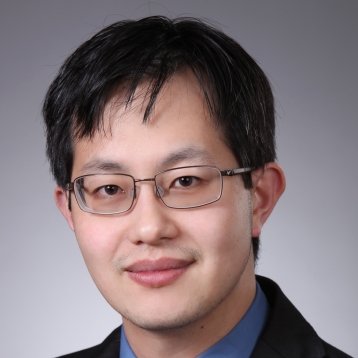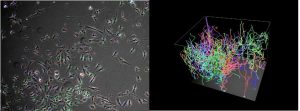
Assistant Professor of the Institute for Tissue Engineering and Regenerative Medicine
Office: (852) 3943 4497
Email: elmerker@cuhk.edu.hk
Address: Room 425D, 4/F, Lo Kwee-Seong Integrated Biomedical Science Building, Area 39, CUHK
ORCID: 0000-0003-3434-8390
SBS Website: https://www2.sbs.cuhk.edu.hk/en-gb/people/academic-staff/prof-ker-dai-fei-elmer
Website: https://ker-lab.weebly.com/
Personal Statement and Research Goals
Regenerative medicine is a highly interdisciplinary field requiring expertise in a wide breadth of topics including material fabrication and characterization, stem cells, wound healing and immunology to engineer safe and effective therapies. Prof. Ker’s long term goal is to investigate and discover biological principles that govern cell behavior and apply these principles to engineer biomaterials for musculoskeletal diseases and trauma.
Contributions to Science and Selected Publications
A. Regenerative biology. Ker has developed expertise in time-lapse microscopy and RNA-seq to better understand differentiation of megakaryocytes and rapid bone regeneration in non-model systems such as deer antlers.
- Ker DFE, Wang D, Sharma S, Zhang B, Passarelli B, Neff N, Li C, Maloney W, Quake S, Yang YP. “Identifying deer antler uhrf1 proliferation and s100a10 mineralization genes using comparative RNA-seq.” Stem Cell Research & Therapy, 2018; 9(1):292.
- Gao Y, Smith E, Ker DFE, Campbell PG, Cheng E, Zou S, Lin S, Wang L, Halene S, Krause DS. “Role of RhoA specific guanine exchange factors in regulation of endomitosis in megakaryocytes.” Developmental Cell, 2012; 22(3):573-584.
B. Musculoskeletal tissue engineering and regenerative medicine. Ker has developed expertise in growth factor bioprinting and engineering technologies to create novel biomaterials for musculoskeletal applications including bone, bone-tendon, and vascular repair.
- Ker DFE*¶, Wang D*, Behn AW, Wang ETH, Zhang X, Zhou BY, Mercado-Pagan AE, Kim S, Kleimeyer J, Gharaibeh B, Shanjani Y, Nelson D, Safran M, Cheung E, Campbell P, Yang YP¶. “Functionally-graded, bone- and tendon-like polyurethane for rotator cuff repair.” Advanced Functional Materials, 2018; 28(20):1707107. *Co-first authors. ¶Co-corresponding authors. Mechanically-robust biomaterial with macroscale bone- and tendon-like strength and modulus which reduces stress concentrations. US Patent Filed.
- Ker DFE, Wang ETH, Sharma R, Yang YP. “Development of mRuby2-transfected C3H10T1/2 fibroblasts for musculoskeletal tissue engineering.” PLoS ONE, 2015; 10(9):e0139054. ATCC CRL-3268: (http://www.atcc.org/Products/All/CRL-3268.aspx)
- Mercado-Pagan, Ker DFE, Yang Y. “Hemocompatibility evaluation of elastomeric hollow fiber membranes as vascular grafts.” Journal of Biomaterial Applications, 2014; 29(4):557-565.
- Ker DFE, Chu B, Phillippi JA, Gharaibeh B, Huard J, Weiss LE, Campbell PG. “Engineering spatial control of multiple differentiation fates within a stem cell population.” Biomaterials, 2011; 32(13): 3413-3422. Simultaneous control of cell alignment and patterning of muscle, tendon, and bone within the same construct.
- Ker DFE, Nain A, Weiss LE, Wang J, Suhan J, Amon C, Campbell PG. “Bioprinting of growth factors onto aligned sub-micron fibrous scaffolds for simultaneous control of cell differentiation and alignment.” Biomaterials, 2011; 32(32):8097-8107.
C. Computer-aided cell tracking. Ker has developed expertise in computer-aided cell tracking. I am current exploring deep-learning approaches to recognize and track stem cells via phase-contrast microscopy. The resulting work generates large volumes of untapped biological data which will be useful to quantify musculoskeletal cell behavior as well as provide quality assurance and control for automated stem cell manufacturing.
- Ker DFE, Eom S, Sanami S, Bise R, Pascale C, Yin Z, Huh S, Osuna-Highley E, Junkers SN, Helfrich CJ, Liang PW, Pan J, Jeong S, Kang SS, Liu J, Nicholson R, Sandbothe MF, Van PT, Liu A, Chen M, Kanade T, Weiss LE and Campbell PG. “Phase contrast time-lapse microscopy datasets with automated and manual cell tracking annotations.” Scientific Data, 2018; 5:180237.
- Ker DFE, Weiss LE, Junkers SN, Chen M, Yin Z, Sandboth MF, Huh S, Eom S, Bise R, Osuna-Highley E, Kanade T, Campbell PG. “An engineered approach to stem cell culture: automating the decision process for real-time adaptive subculture of stem cells.” PLoS ONE, 2011; 6(11):e27672.
Musculoskeletal Tissue Engineering and Regeneration
The musculoskeletal system is an intricate network comprised of hard and soft tissues including bone, tendon, and muscle and functions to facilitate body movement. Injuries and diseases affecting the musculoskeletal system dramatically impacts our quality of life and is the 2nd largest contributor to global disability.
Recently, Prof. Elmer Ker in collaboration with Prof. Dan Wang have developed a novel biomaterial with bone- and tendon-like mechanical properties for treating rotator cuff tears of the shoulder. Specifically, this biomaterial can robustly withstand at least 100,000 cycles of physiologic loading without failure and can reduce stress concentrations via gradual gradation, minimizing chances of material failure that could result in re-tears.

Photoelastic stress analysis of musculoskeletal biomaterials. Different colours correspond to different amounts of stress or strain within the sample and enable us to detect where a material may fail.
In addition to his work on biomaterials, Prof. Elmer Ker is also interested in developing computer-aided approaches to track cells in culture using label-free, phase-contrast timelapse microscopy. This work is ongoing and will be useful as a tool to study and quantify cell behaviors for basic biological studies as well as for quality control assessment during stem cell expansion or manufacturing.

Computer-aided cell tracking. The left panel shows a phase-contrast microscope image of cells with their detected cell centroids while the right panel shows a family (cell lineage) tree as a function of time and space.
Grant Record
- Health Medical Research Fund [PI; 2021-2024]: “3D-printed, mechanically-graded and growth factor-biopatterned polyurethane for rotator cuff repair” (HK$1,373,108).
- Early Career Scheme, Research Grants Council [PI; 2021]: “A semi-automated computer vision-based pipeline for label-free cell instance segmentation in musculoskeletal tissue engineering” (HK$1,017,005).
- Innovation Technology Fund Tier 3 [PI; 2019-2020]: “Repairing tendon injuries with tissue mimetic biomaterials” (HK$1,398,505).
- CUHK – Faculty Innovation Award [PI; 2019-2023]: “Multi-tissue engineering of myotendinous graft for rotator cuff repair” (HK$2,500,000).
- Stanford University Spectrum MedTech [PI; 2017]: “Development of a hybrid suture anchor-tendon graft for rotator cuff repair” (US$50,000).
- AO Foundation Start-up Grant [PI; 2014-2017]: “Development of a functionally graded polyurethane biomaterial for rotator cuff injury” (CHF118,000 or ~US$126,000).

